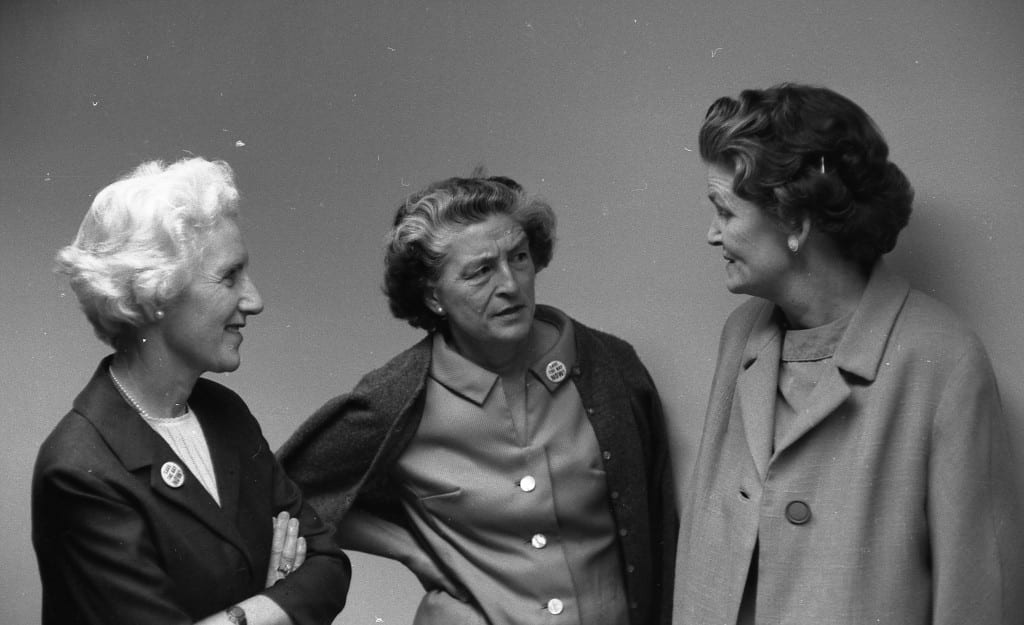
| This year marks sixty years of saving the Bay. We will celebrate, honor and share stories from our history throughout the year. We invite you to join us and share your own stories of your own connection to the Bay on Instagram, Facebook, or Twitter #MyBayStory.
This story was written in our co-founder Sylvia McLaughlin’s words from a series of interviews with her. Originally published on September 9, 2013. |
Kay, Esther, and I sat in Kay’s living room in the Berkeley Hills, nervous, yet hopeful. We heard a car pulling into the driveway and I said to my friends, “Here we go.” Surely these men who cared so much about redwoods and birds would also want to save our Bay.
Esther served coffee as we took our seats. On one side of the shiny coffee table sat the three of us “tea ladies” in our colorful suits. On the other side, facing the big window with views of the Golden Gate Bridge towering above the glistening blue water, sat three men in dark suits – the executive directors of Save The Redwoods League, the Audubon Society, and the Sierra Club.
Kay, Esther and I described the problem: The Bay was steadily becoming smaller. Its primary use, other than shipping, was as a place to dump sewage and garbage. When Kay described the awful stench wafting from the shoreline and how at night she could see the Bay on fire where garbage had been dumped in the shallows and set ablaze, they nodded knowingly. I was sure that we had won their support, so I confidently asked, “What can you do to save the Bay?”
The Sierra Club director responded first: “I’m sympathetic to your cause. But we are pouring all of our resources into opposing the Grand Canyon dams. We can’t launch anything new.”
The other leaders responded similarly. The Redwoods League was busy saving the forests. Audubon was occupied with preserving bird habitats. The Sierra Club exec concluded: “It looks like there will have to be a new organization. We’ll give you our mailing lists and help you all we can.”
Then they filed out and wished us luck. We were deflated.
It was 1960 in Berkeley, California. While the free speech movement was gearing up at the University of Berkeley just down the hill, there was also a “progressive” movement to fill in the Bay. Starting with the Gold Rush, San Francisco Bay had been developed at a rapid rate. By 1960, 90 percent of the Bay’s wetlands were gone and the Bay was a third smaller than it had been. From our house I could see a continuous stream of trucks dumping garbage and fill into the water. One day I opened up the newspaper and saw something that sent shivers down my spine. It was an image entitled “Bay or River?” showing that the Bay would become a narrow channel by 2020 if all the various development plans being proposed came to fruition.
At that time, nature conservation in an urban setting was an alien concept. The first Earth Day was still 10 years away. The EPA didn’t exist. While chatting over almond cookies and tea, Kay, Esther, and I came to the conclusion that the Bay needed saving. That’s how we came to be meeting with those men from the largest conservation organizations. But once we heard the car pull away I said, “Well, that didn’t turn out as planned. But it is clear that if anything is going to be done, we are ‘it.’ Let’s get to work.”
Shortly thereafter we sent a letter to everyone we knew inviting them to join Save San Francisco Bay Association for one dollar. We didn’t know if anyone would respond, but a few days later we got our first batch of one dollar checks and even more came the following day. We ended up with a wonderful response – more than 90 percent!
Our first move was to lobby for a new state agency that could regulate development. Senator Eugene McAteer was business friendly, but he also had a restaurant on the Bay. Kay convinced him that it would be good for business to protect this natural resource. In 1965 Senator McAteer and Assemblyman Nicholas Petris co-sponsored a successful bill – the McAteer-Petris Act – which established The Bay Conservation and Development Commission (BCDC). BCDC had two major responsibilities: to prepare a master plan for the Bay and grant or deny permits for Bay filling. We had to keep fighting to assure that BCDC became a permanent agency. We rallied our fellow citizens who wrote letters and telegrams, made calls and even descended on the capital in busloads. After eight years of hard work, the bill passed by just one vote. Governor Reagan signed it and created the agency that is still the main regulatory agency over the Bay today comprised of citizens and public representatives from around the Bay.
Today, I’m proud that Save The Bay remains the largest regional organization working to protect and restore this great natural treasure.
Recently, one of my grandson’s friends asked me a question I’m asked often: “Sylvia, isn’t the Bay saved already?”
I quoted my friend Kay: “The Bay is always in the process of being saved. That is why we have been working so hard for all these years and why it’s important that you and your friends continue to protect it far into the future. Let’s keep it going!”

















































